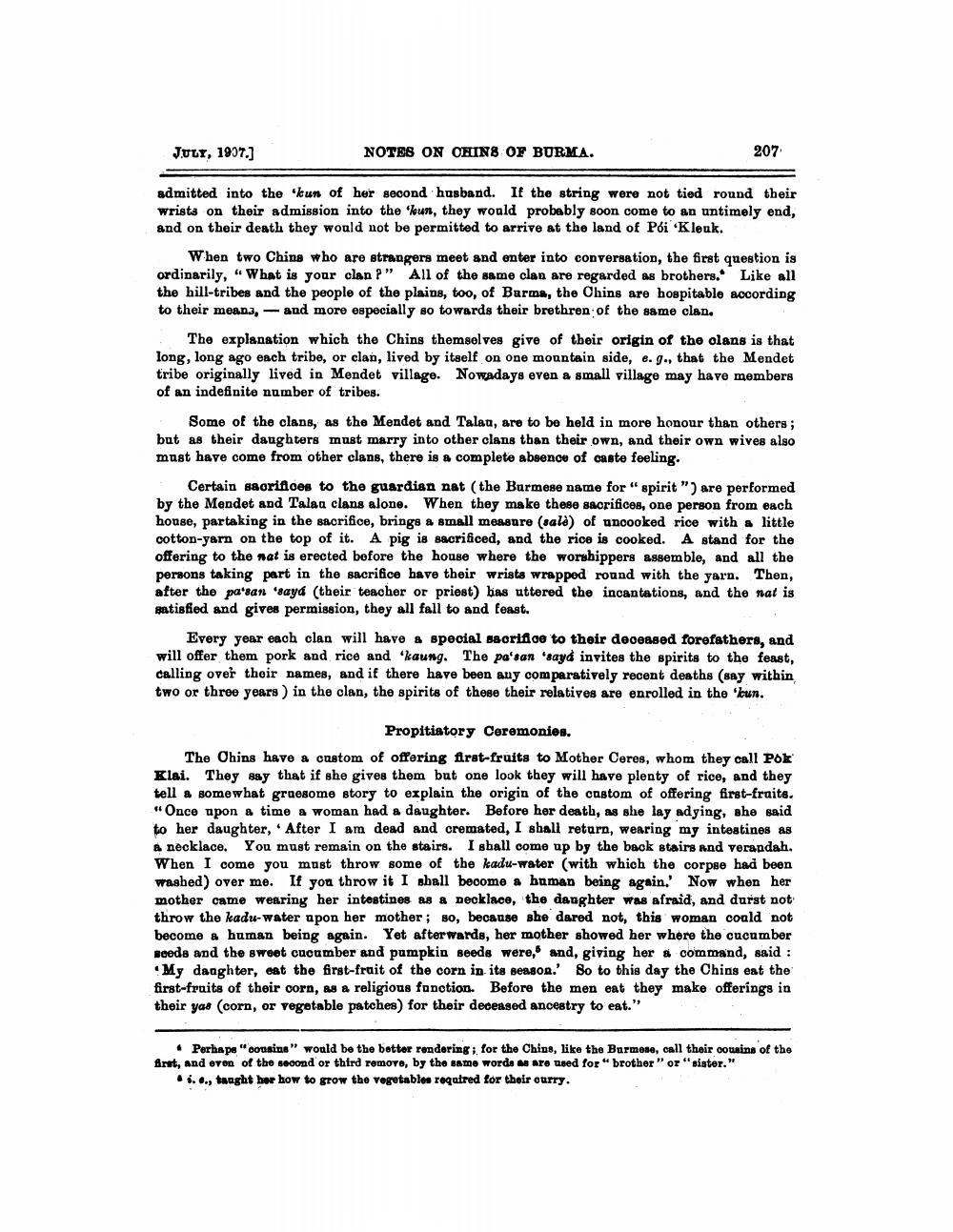________________
JULY, 1997.]
NOTES ON OHINS OF BURMA.
207
admitted into the sun of her second husband. If the string were not tied round their wrists on their admission into the fun, they would probably soon come to an untimely end, and on their death they would not be permitted to arrive at the land of Pói Kleuk.
When two China who are strangers meet and enter into conversation, the first question is ordinarily, “What is your clan ?" All of the same clan are regarded as brothers. Like all the hill-tribes and the people of the plains, too, of Barma, the Chins are hospitable according to their means, and more especially so towards their brethren of the same clan.
The explanation which the Chins themselves give of their origin of the olans is that long, long ago each tribe, or clan, lived by itself on one mountain side, 6.9., that the Mendet tribe originally lived in Mendet village. Nowadays even a small village may have members of an indefinite number of tribes.
Some of the clans, as the Mendet and Talaa, are to be held in more honour than others; but as their daughters must marry into other clans than their own, and their own wives also must have come from other clans, there is a complete absence of caste feeling.
Certain sacrifices to the guardian nat (the Burmese name for "spirit") are performed by the Mendet and Talaa clans alone. When they make these sacrifices, one person from each house, partaking in the sacrifice, brings a small measure (sald) of uncooked rice with a little cotton yarn on the top of it. A pig is sacrificed, and the rice is cooked. A stand for the offering to the nat is erected bofore the house where the worshippers assemble, and all the persons taking part in the sacrifice have their wrists wrapped round with the yarn. Then, after the pa'san saya (their teacher or priest) bas uttered the incantations, and the nat is satisfied and gives permission, they all fall to and feast.
Every year each clan will have a special sacrifice to their deceased forefathers, and will offer them pork and rice and 'kaung. The pa'san 'saya invites the spirits to the feast, calling over their names, and if there have been auy comparatively recent deaths say within two or three years ) in the clan, the spirits of these their relatives are enrolled in the 'kun.
Propitiatory Ceremonies. The Ohins have a custom of offering first-fruits to Mother Ceres, whom they call Pok Klai. They say that if she gives them but one look they will have plenty of rice, and they tell a somewhat gruesome story to explain the origin of the custom of offering first-fraite. "Once apon a time a woman had a daughter. Before her death, as she lay adying, she said to her daughter, After I am dead and cremated, I shall return, wearing my intestines as & necklace. You must remain on the stairs. I shall come up by the back stairs and verandah. When I come you must throw some of the kadu-water (with which the corpse had been washed) over me. If you throw it I shall become a human being again. Now when her mother came wearing her intestines as a necklace, the daughter was afraid, and durst not throw the kadu-water apon her mother; so, because she dared not, this woman could not become & human being again. Yet afterwards, her mother showed her where the cucumber needs and the sweet cucumber and pumpkin seeds were, and, giving her & command, said:
My daughter, eat the first-frait of the corn in its season.' So to this day the Chins eat the first-fruits of their corn, as a religious fonction. Before the men eat they make offerings in their yas (corn, or vegetable patches) for their deceased ancestry to eat."
• Perhaps "cousins" would be the better rendering; for the Chins, like the Burmese, call their cousins of the first, and even of the second or third remove, by the same words as are used for “brother" or "sister."
#1..., taught her how to grow the vegetables roqatred for their ourry.




